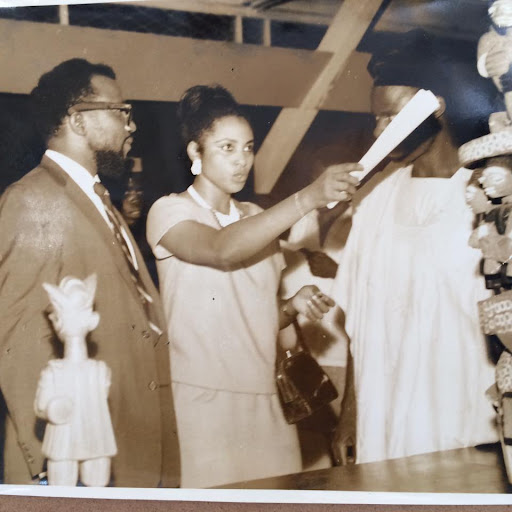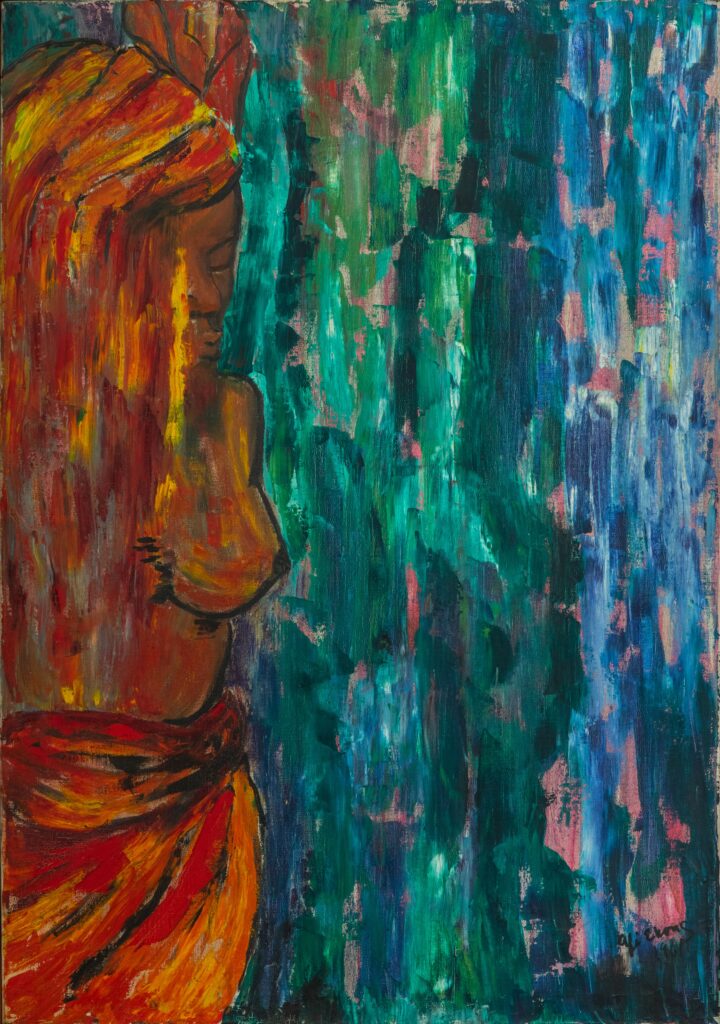
Chief Lady Constance Afiong Ekong
Along with being a pioneer of modern Nigerian and African art, Chief Lady Constance Afiong Ekong also known as Afi Ekong, was an art collector, fashion designer, jewelry maker, and entrepreneur. Ekong was a present and influential figure in the Nigerian art scene until her death in 2009.
Afi Ekong was born in Duke Town, Calabar, Nigeria on June 26, 1930. She was born into the royal house of the Obong of Calabar. Her professional art training began at Oxford City Technical School (1951-1953), where she trained as a painter and fashion designer. In 1955, she attended St Martin’s School of Fine Arts and later studied history of costumes at the Central School of Arts, which she completed in 1957. Ekong’s art training in England made her one of the first generation of Nigerian artists to receive their training abroad. Other firsts for Ekong include: being the first female artist in Nigeria to be academically trained and the first female artist to exhibit in Nigeria.
In the 1960s, Ekong became an executive board member and art manager of the Lagos Art Council and supervisor of Gallery Labac (Lagos Branch of the Art Council). In order to grow interest in art and showcase the art of other Nigerian artists, Ekong created Cultural Heritage, a weekly television program. She used her platform to broadcast the works of artists such as Yusuf Grillo, Solomon Wangboje, Uche Okeke and Simon Okeke. By 1966, she had opened The Bronze Gallery, the first private art gallery in Nigeria. Due to her work of promoting art and women’s education in West Africa, she was awarded “The Star of Dame Official of the Human Order of African Redemption” in 1962 by the former President of Liberia, William Tubman. Ekong’s work of improving the lives of women continued into the 1980s when she became the Chairman for the International Council of Women Standing Committee. In 1994, she opened The Bronze Gallery in Fiekong Estate which showcased not only her art to the public but the art of other Nigerian artists.
Afi Ekong was the first female artist to have a solo exhibition in Nigeria. Her solo exhibition was held at the Exhibition Centre during the Lagos Festival of Arts in 1958. In 1961, she had another solo exhibition titled Afi Ekong at Galeria Galatea in Buenos Aires, Argentina. Group exhibitions that have included Ekong’s work are, Art from Africa of Our Time, Phelps-Stokes Fund (1962); First World Festival of Negro Arts (1966); and Women Now, National Gallery of Crafts and Design (1990). Examples of Ekong’s work shows her versatility when it comes to her use of color, subject matter, and technique.
Grief by Afi Ekong

At a considerable height of 40 9/16 inches and a width of 28 13/16 inches, Grief depicts a woman with her eyes closed and head slightly tilted down. One of her breasts is exposed while the other is concealed by a waterfall of reds, oranges, and yellows. This coloring continues to the rest of the woman’s body and clothing. The woman’s large fiery body automatically draws the viewer’s attention, especially considering its juxtaposition with the cooler background colors of blue and green. Although the thick blue and green lines take up much of the canvas, pink and exposed canvas can be seen underneath the blues and greens.
The woman in Grief resembles more of an idea or the embodiment of grief. We can argue that the woman is not just experiencing grief but she is actually grief. We usually associate dark colors with grief such as black at funerals. Ekong has gone in the opposite direction by using fiery colors to depict grief as an emotion that is consuming and quick-spreading like fire. Ekong allows us to see grief how she might have seen it. An emotion of solitude, seen through the lone woman left to one side of the painting but also a raging emotion, seen through the depiction of a woman consumed by the colors of fire.